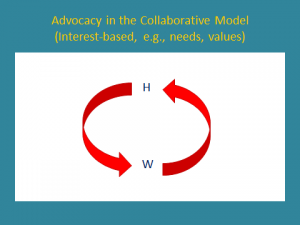 In Part I we learned that “rights-based” advocacy in the Court Model is hard on the problem but also hard on the people. Advocacy in the “interest-based” Collaborative Model is also hard on the problem, but SOFT on the people. How is this possible?
In the Collaborative Model, the parties voluntarily agree to reach a settlement outside of court. Thus the 3rd party decision-maker, e.g., the judge, is removed from the collaborative process. Instead, the decision-maker is the parties themselves!
In order to reach a settlement, the parties must consider and honor the other party’s perspective. In the Collaborative Model, advocacy is not about the position a client takes on a particular issue, but about meeting the future needs, interests, and goals that are defined by the couple themselves. By framing the problem in terms of needs, interests and goals, parties are likely to see their dispute as a mutual problem that they must work together to solve. They now answer the question: how do we both get our needs and interests met? How does our family get its needs and interests met?
Advocacy in the Collaborative Model encourages parties to look behind their opposed positions to determine the motivating interests. In doing so, the parties often find alternative solutions that meet the needs of both sides. Collaborative advocacy pays attention to balance, listening and being creative. Collaborative advocacy creates an incentive to work together, acknowledge the other, to be authentic and realistic. This kind of collaboration can occur only in an atmosphere that is respectful, transparent, and mutual; and one that incentivizes caring about the other party’s point of view with the removal of the 3rd party decision-maker. While being hard on the problem and soft on the people seems to be a contradiction, it is this contradiction that promotes better settlements and preserves needed relationships. Who knew that removing the 3rd party decision-maker could make such a difference!
In Part III, I will explore how the power of neutrality is the secret sauce to a successful collaborative divorce.
In Part I we learned that “rights-based” advocacy in the Court Model is hard on the problem but also hard on the people. Advocacy in the “interest-based” Collaborative Model is also hard on the problem, but SOFT on the people. How is this possible?
In the Collaborative Model, the parties voluntarily agree to reach a settlement outside of court. Thus the 3rd party decision-maker, e.g., the judge, is removed from the collaborative process. Instead, the decision-maker is the parties themselves!
In order to reach a settlement, the parties must consider and honor the other party’s perspective. In the Collaborative Model, advocacy is not about the position a client takes on a particular issue, but about meeting the future needs, interests, and goals that are defined by the couple themselves. By framing the problem in terms of needs, interests and goals, parties are likely to see their dispute as a mutual problem that they must work together to solve. They now answer the question: how do we both get our needs and interests met? How does our family get its needs and interests met?
Advocacy in the Collaborative Model encourages parties to look behind their opposed positions to determine the motivating interests. In doing so, the parties often find alternative solutions that meet the needs of both sides. Collaborative advocacy pays attention to balance, listening and being creative. Collaborative advocacy creates an incentive to work together, acknowledge the other, to be authentic and realistic. This kind of collaboration can occur only in an atmosphere that is respectful, transparent, and mutual; and one that incentivizes caring about the other party’s point of view with the removal of the 3rd party decision-maker. While being hard on the problem and soft on the people seems to be a contradiction, it is this contradiction that promotes better settlements and preserves needed relationships. Who knew that removing the 3rd party decision-maker could make such a difference!
In Part III, I will explore how the power of neutrality is the secret sauce to a successful collaborative divorce.
Two Paths, One Decision: The Divorce Dilemma
Emily and Daniel were in love. Their love story had once been the envy of the neighborhood—a whirlwind romance that blossomed into a marriage filled with laughter, shared dreams, and whispered secrets. But as the years went by, cracks appeared in their fairy tale....




